Dogwood myths and legends have been passed down through generations in different cultures. These stories often involve the symbolism and significance of the dogwood tree, connecting it to various aspects of spirituality, nature, and historical events. Let’s delve into the enchanting world of dogwood myths and legends tales that have captivated hearts for generations.
Key Takeaways:
- Dogwood myths and legends have been cherished and passed down through generations in different cultures.
- These stories often connect the dogwood tree to spirituality, nature, and historical events.
- The Legend of the Dogwood Tree is a popular myth associated with the symbolism of the dogwood flower in Christianity.
- Dogwood holds magic, medicinal, and ecological significance in various traditions.
- The dogwood tree has been utilized for various purposes throughout history, including in crafts and traditional medicine.
The Legend of the Dogwood Tree
One popular dogwood myth is the Legend of the Dogwood Tree. According to this legend, Jesus was nailed to a cross made from dogwood timber and blessed the tree before his death. The dogwood tree, as a result, was transformed to never grow tall or straight enough to be used for crucifixion again.
The white blooms of the dogwood flower symbolize Christ’s purity, while the red tinges on the edges represent his blood. The petal shape forms a cross with notched edges, reminding believers of the nails that held Jesus on the cross, and the golden center represents the crown of thorns.
While this story may not be historically accurate, it continues to be cherished and shared in various communities.
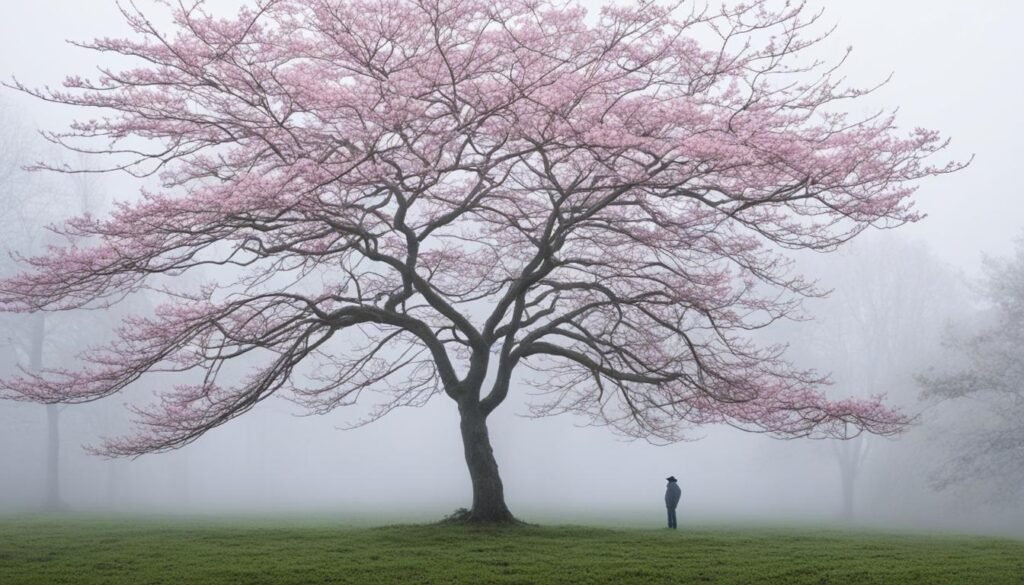
Note: The image above represents the significance and symbolism of the Dogwood Tree in the Legend.
The Magic and Sacredness of Dogwood
Dogwood trees hold a special place in the natural world, and they have been revered for their magic and sacred qualities. In the druidic tradition, dogwood is often overlooked, but it has much to offer in terms of medicine, ecology, and spiritual significance. Native to North America, dogwood is found in the understories of forests and is a common ornamental tree. Its beautiful white or pink bracts and yellowish flowers make it a visually striking tree. Exploring the magic, mythology, medicine, and human uses of dogwood can help us connect with its sacred energy.
From a Druidic perspective, dogwood represents a connection between Earth and the spiritual realm. It is seen as a gateway to the divine, carrying a unique energy that can assist in spiritual practices and rituals. The tree’s flowering patterns and vibrant colors symbolize the cycles of life, renewal, and the interconnectedness of all living beings.
The spiritual significance of dogwood transcends its physical presence. It is believed to possess healing properties and is used in traditional herbal medicine. Dogwood bark, leaves, and flowers are known to contain compounds that have been used to treat various ailments, including fevers, respiratory infections, and digestive issues.
The Ecology of Dogwood
In addition to its magical and spiritual qualities, dogwood plays an important ecological role. As an understory tree, it thrives in the shade of larger trees, providing habitat and shelter for a diverse array of wildlife. Birds, squirrels, and other animals rely on the berries and seeds of the dogwood tree as a vital food source. The tree also supports a range of insect species, contributing to the overall biodiversity of forest ecosystems.
The growth habit of dogwood, with its spreading branches and dense foliage, offers protection for smaller understory plants and contributes to soil stability. It helps prevent erosion, maintaining the health and balance of forest ecosystems.
Magical Uses of Dogwood
Throughout history, dogwood has been associated with various magical practices and folklore. In some traditions, it is believed that carrying a piece of dogwood can provide protection against negative energies and evil spirits. The wood of the dogwood tree is said to have the power to ward off hexes and curses.
Furthermore, dogwood has been used in love spells and rituals. It is believed to enhance romantic energy, attract love and friendship, and strengthen existing relationships. The tree’s blossoms and twigs have been incorporated into love potions and charms, harnessing the mystical energy of dogwood to foster love and passion.
| Magical Uses of Dogwood | Effect |
|---|---|
| Protection Magic | Warding off negative energies and evil spirits |
| Love Spells | Enhancing romantic energy and attracting love |
| Divination | Using dogwood twigs for dowsing and seeking spiritual guidance |
| Healing Rituals | Harnessing the medicinal properties of dogwood in energy healing |
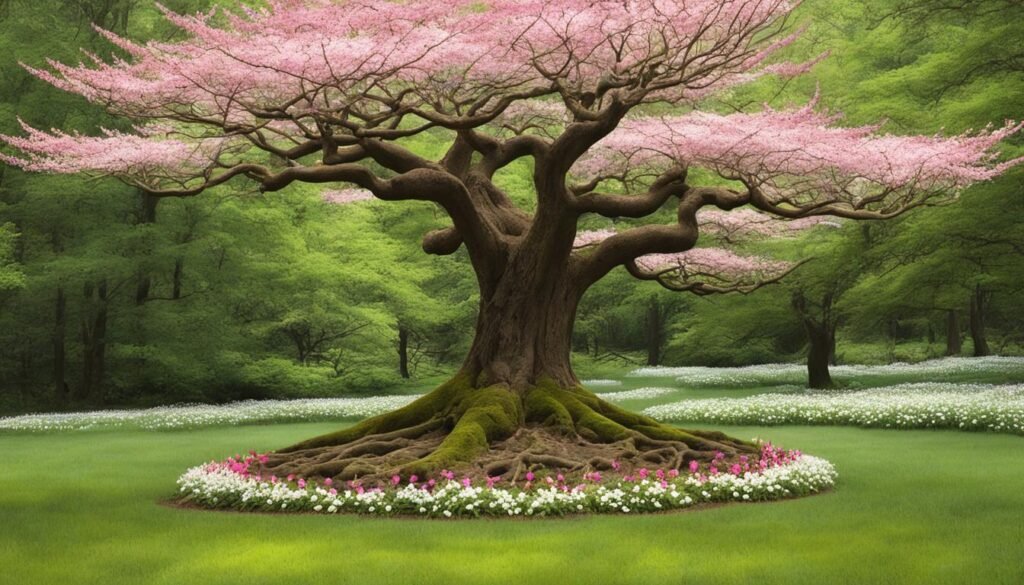
| Ecological Role of Dogwood | Contributions |
|---|---|
| Habitat | Provides habitat for birds and small mammals |
| Food Source | Flowers attract pollinators; berries provide food for birds |
| Canopy Structure | Contributes to forest diversity as an understory tree |
| Erosion Control | The tree’s root system helps prevent soil erosion |
By understanding the ecological role of dogwood and its significance as a habitat provider and food source, we can appreciate the importance of preserving and supporting the growth of this magnificent tree species in our natural environments.
Human Uses of Dogwood
Dogwood has been a valuable resource for humans throughout history, serving various purposes in traditional crafts, medicine, folklore, and superstitions.
Uses of Dogwood Wood
The hard and tough wood of the dogwood tree has been highly regarded for its durability and workability. It has been used in crafting tools, such as handles for hammers and chisels, as well as in turning to create decorative wooden objects. Additionally, dogwood wood has been utilized in making inks and dyes for artistic purposes.
Dogwood in Traditional Crafts
Dogwood has played a significant role in traditional crafts in different cultures. Its smooth and fine-grained wood makes it ideal for intricate carving, turning, and sculpting. Dogwood has been used to create decorative items, furniture, walking sticks, and even musical instruments like flutes and whistles.
Dogwood in Traditional Medicine
The inner bark and twigs of the dogwood tree have been traditionally used in medicinal practices. In various cultures, dogwood has been employed to treat ailments such as malaria, colds, and fevers. Its bark and twigs were often boiled or brewed into teas and extracts for their potentially beneficial properties.
Dogwood in Folklore and Superstitions
Along with its practical uses, dogwood has been steeped in folklore and superstitions. In many traditions, dogwood has been associated with protection against evil spirits and negative energy. It has been believed to ward off harm and provide a shield against malevolent forces. Dogwood has also been linked to love spells, with its branches and flowers being utilized in rituals and charms to attract or strengthen romantic relationships.
| Application | Examples |
|---|---|
| Craftsmanship | Carving, turning, sculpting |
| Toolmaking | Handles for hammers, chisels |
| Artistic Expression | Inks, dyes, decorative objects |
| Traditional Medicine | Treating malaria, colds, fevers |
| Folklore and Superstitions | Protection, love spells |
The diverse uses of dogwood illustrate its versatility and cultural significance. From the delicate craftsmanship to the medicinal and mystical properties attributed to it, dogwood continues to be cherished and respected for its contribution to various aspects of human life.
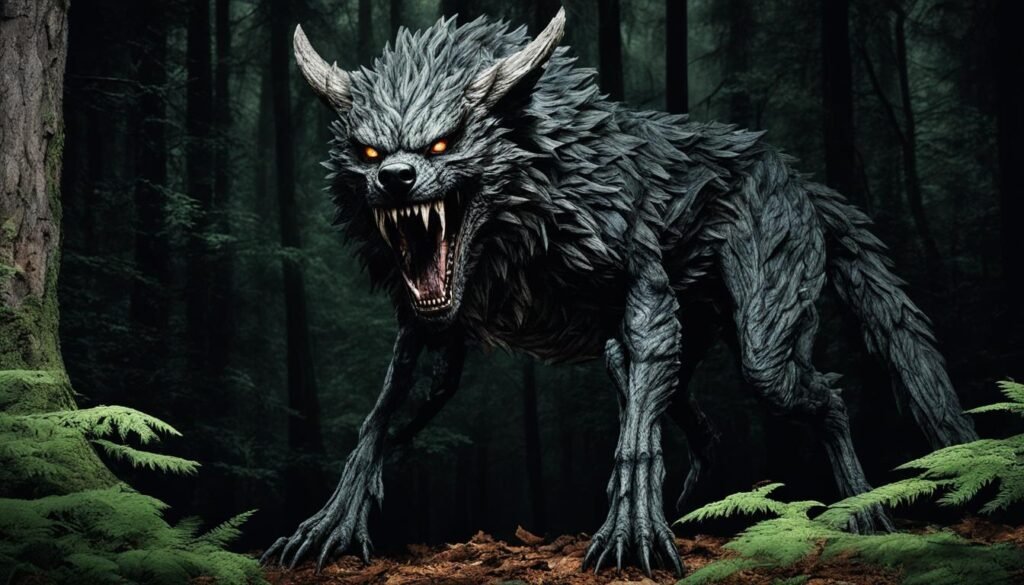
Ozark’s Snawfus and Cernunnos
“The Snawfus is believed to embody attributes of Cernunnos, the Celtic god of the wild, death, and nature. By bridging mythologies, the Snawfus symbolizes the connection between the natural world, spirituality, and the mysteries that lie beyond.”
| Snawfus Symbolism | Dogwood Symbolism |
|---|---|
| Enigmatic creature roaming Ozark Mountains | Sacred tree represented by dogwood branches |
| Giant white deer-like appearance | Historical connection to Christianity |
| Accompanied by a mystical blue haze | Link to ancient Celtic beliefs |
| Portends imminent death | Representation of death and nature |
Dogwood in Ozark Folklore and Superstitions
In Ozark folklore, the dogwood tree holds significance beyond its natural beauty. It was believed to bring protection against harm, and pieces of dogwood were carried to ward off Mad Dog bites. Dogwood was also used in medicine, particularly for treating colds and fevers. Additionally, dogwood and redbud were ingredients in love spells practiced by Ozark residents. These beliefs and practices are a testament to the deep-rooted cultural significance of dogwood in the Ozark region.
Protective Uses of Dogwood
The people of the Ozarks revered the dogwood tree for its protective properties. They believed that carrying a piece of dogwood would shield them from harmful influences, both physical and spiritual. It was common for individuals to keep a small fragment of dogwood wood or a twig in their pockets or purses as a talisman of protection.
Dogwood in Medicine
In addition to its protective uses, dogwood was highly valued for its medicinal properties in Ozark culture. The bark of the dogwood tree was often used to brew herbal teas and tinctures, which were believed to alleviate cold and flu symptoms, reduce fever, and soothe various ailments.
Furthermore, the bark and leaves of the dogwood tree were used as poultices to treat skin conditions such as rashes and sores. It was believed that the natural compounds found in dogwood possessed healing qualities that could aid in the recovery process.
Love Spells in the Ozarks
The people of the Ozarks also incorporated dogwood into their love spells and rituals. Dogwood, along with redbud, was believed to possess powerful aphrodisiac properties. These trees were seen as symbols of romance and passion, and their blossoms were thought to have the ability to ignite or enhance feelings of love and desire.
“Under the light of the full moon, Ozark lovers would gather dogwood and redbud flowers, whispering their desires and wishes for love. They believed that the magical essence of these blossoms would bring about true love and lasting connections.”
The practice of using dogwood and redbud flowers in love spells was passed down through generations and remained an integral part of Ozark folklore and superstitions surrounding love and relationships.
| Protective Uses of Dogwood | Dogwood in Medicine | Love Spells in the Ozarks |
|---|---|---|
| Protection against harm | Alleviating cold and flu symptoms | Igniting feelings of love and desire |
| Warding off Mad Dog bites | Reducing fever | Enhancing romantic connections |
| Soothing ailments |
The protective uses of dogwood, its medicinal properties, and its association with love spells illustrate the diverse and deeply embedded role of dogwood in Ozark lore and traditions. Through these practices, the people of the Ozarks paid homage to the sacred nature of the dogwood tree and harnessed its power for various purposes.
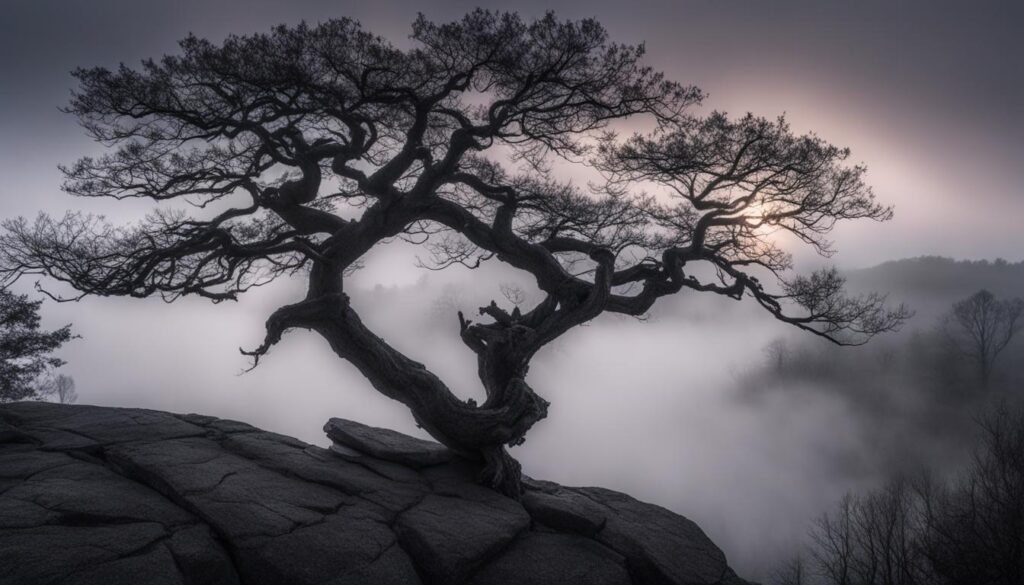
Dogwood Symbolism and Significance in Christianity
In Christian symbolism, the dogwood tree holds a special place. While the specific legends surrounding the dogwood tree may vary, the symbolism and religious significance remain consistent.
According to Christian legends about the dogwood, some stories connect the dogwood tree to Jesus, portraying it as his favorite tree or as the wood used for his crucifixion. Though these specific details may be disputed, the dogwood tree has enduring religious symbolism within Christian traditions.
“The dogwood flower carries rich symbolism in Christianity. The unique shape and colors of the dogwood flower are often seen as representations of various elements of the crucifixion story. The four white petals, arranged in the shape of a cross with notched edges, remind believers of the nails that held Jesus on the cross. The red tinges on the edges symbolize his blood, and the golden center represents the crown of thorns. This symbolism serves as a visual reminder of Christ’s sacrifice and the redemption offered through his death and resurrection.”
In addition to the symbolic representation of the crucifixion, the timing of the dogwood’s blooming season is also significant in Christian symbolism. The dogwood typically blooms around Easter, the time when Christians commemorate the death and resurrection of Jesus. This timing further enhances the religious symbolism and reinforces the dogwood’s significance within Christian traditions.
The enduring symbolism and religious significance of the dogwood tree in Christianity showcase the powerful connection between nature and spirituality in various cultural narratives.
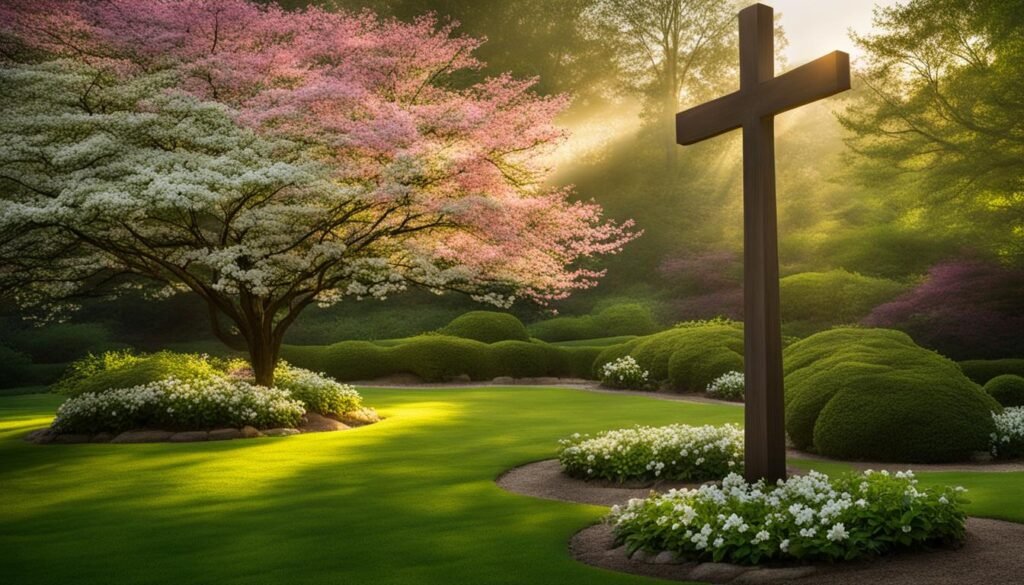
| Symbolism | Description |
|---|---|
| Petals in the shape of a cross | Represents the nails that held Jesus on the cross |
| Red tinges on the edges | Symbolizes Jesus’ blood |
| Golden center | Represents the crown of thorns |
Dogwood in Traditional and Indigenous Beliefs
Dogwood trees have long held a significant place in the beliefs and practices of indigenous cultures around the world. These majestic trees are revered as sacred symbols, representing a deep connection to nature, fertility, and spirituality.
The cultural significance of dogwood can be traced back through generations, with each culture attributing its own unique meanings and rituals to this sacred tree. From Native American traditions to ancient Celtic beliefs, dogwood has been regarded as a powerful symbol of natural harmony and spiritual enlightenment.
“In my tribe, the dogwood tree is considered a bridge between the physical and spiritual worlds. Its branches reaching upward symbolize our connection to the creator, while its roots anchoring the earth remind us to stay grounded in our traditions.” – Chief Thunderbird
Indigenous communities have used dogwood in various ceremonies and rituals, invoking its spiritual energy to guide them on their journeys. The tree’s vibrant white or pink blossoms are often associated with purity, renewal, and the cyclical nature of life.
The Cultural Significance of Dogwood
Across different traditions, dogwood holds great cultural significance:
- In Native American cultures, dogwood is seen as a symbol of protection, offering shelter to spirits and providing strength to warriors.
- In European folklore, dogwood was associated with various deities and mythical beings, representing the balance between life and death.
- Ancient Celts regarded dogwood as a tree of transformation and rebirth, carrying the energy of the changing seasons.
The deep reverence for dogwood in traditional and indigenous beliefs reminds us of the interconnectedness between nature, humanity, and the spiritual realm. Exploring these rich cultural traditions can shed light on the profound wisdom and universal truths embedded in the stories and practices surrounding dogwood.

| Tradition | Beliefs and Practices |
|---|---|
| Native American | Dogwood as a sacred tree connecting the physical and spiritual realms, symbolizing protection and grounding |
| Celtic | Dogwood representing transformation, renewal, and the cyclical nature of life |
| European | Associations with deities and mythical beings, symbolizing the balance between life and death |
Understanding the cultural significance of dogwood in traditional and indigenous beliefs allows us to appreciate its profound impact on human spirituality and cultural heritage. It serves as a reminder of our connection to the natural world and the timeless wisdom passed down by our ancestors.
Dogwood in Modern Practices and Rituals
While some of the ancient beliefs and practices surrounding dogwood may have faded over time, there are still modern uses and rituals involving this sacred tree. Dogwood continues to hold significance in various contemporary practices, including nature-based ceremonies, rituals, and seasonal celebrations. Its beauty and symbolism inspire artists, writers, and spiritual practitioners to this day, contributing to a rich tapestry of cultural traditions.
Nature-Based Ceremonies and Rituals
Modern practitioners have incorporated dogwood into nature-based ceremonies and rituals, honoring its symbolic and spiritual qualities. The tree’s delicate flowers, with their white or pink bracts, represent purity and can serve as potent focal points for meditation, prayer, or intention-setting. Dogwood’s branches and leaves may be used to create sacred spaces, altars, or decorative elements to enhance the ambiance of these rituals.
Seasonal Celebrations
During seasonal celebrations, such as spring equinox or Beltane, dogwood plays a prominent role. Its blossoming during the spring signifies renewal, growth, and the awakening of nature. People gather beneath dogwood trees, basking in their beauty and connecting with the energy of the changing seasons. These celebrations often involve music, dancing, and the exchange of meaningful gifts or blessings.
The modern uses of dogwood in rituals and ceremonies showcase our enduring fascination with nature’s wonders and our deep-rooted desire to connect with the natural world and the wisdom of our ancestors.
Artistic Expression and Inspiration
Dogwood’s timeless beauty and symbolism continue to inspire artists and writers. The intricate details of its flowers and the graceful structure of its branches make it a popular subject for visual artists, who capture their essence in paintings, drawings, and photography. Writers draw inspiration from the legends and mythology surrounding dogwood, incorporating its symbolism into their poems, stories, and songs.
The Contemporary Significance of Dogwood
Dogwood’s relevance in modern practices and rituals extends beyond its aesthetics. It serves as a reminder of the interconnection between humans and nature, encouraging us to honor and protect the natural world. The versatility and adaptability of dogwood make it a fitting symbol for resilience, growth, and the potential for transformation.
Modern Uses of Dogwood in Contemporary Practices
| Practice | Description |
|---|---|
| Nature-based ceremonies and rituals | Integrating dogwood into spiritual practices, creating sacred spaces, and using its flowers and branches for meditation and prayer. |
| Seasonal celebrations | Incorporating dogwood into festivals and rituals that mark the changing seasons and honor the cycles of nature. |
| Artistic expression and inspiration | Using dogwood as a subject in visual arts, literature, and music to convey its symbolism and capture its beauty. |
| Connection to nature | Recognizing dogwood as a symbol of our interconnectedness with the natural world and the wisdom of our ancestors. |
Modern practices involving dogwood demonstrate the enduring allure and relevance of this sacred tree. Whether utilized in rituals, celebrations, or artistic expressions, dogwood continues to captivate hearts and minds, offering a profound connection to nature, culture, and spirituality.
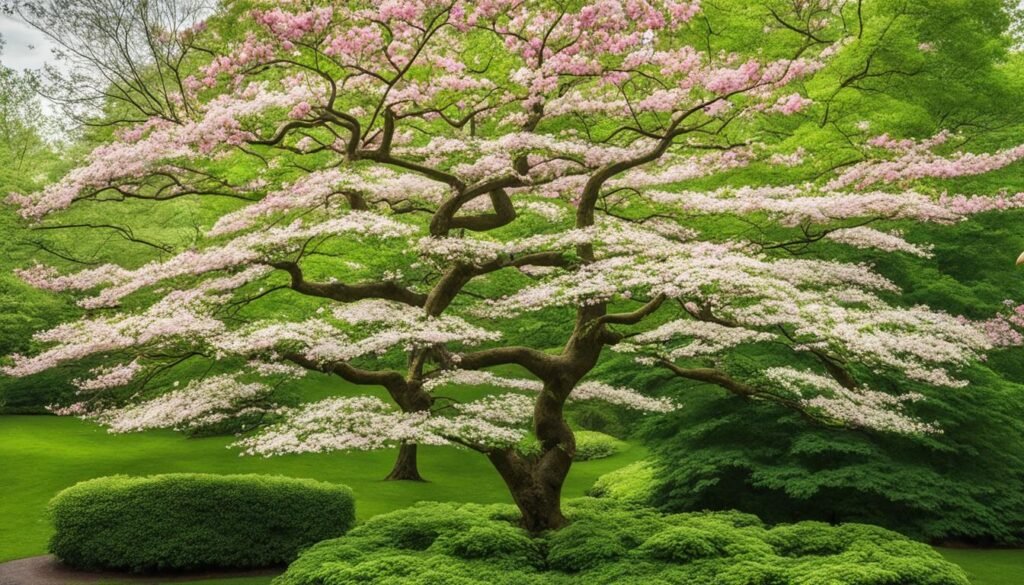
The blooming of dogwood flowers signifies the arrival of spring, a time of rebirth and rejuvenation in the natural world. After the cold winter months, the dogwood’s flowers bring a welcome burst of color and beauty, transforming the landscape into a picturesque scene.
The significance of dogwood flowers in spring goes beyond their aesthetic appeal. Dogwood flowers are a symbol of hope and renewal, representing the cycle of life and the promise of new beginnings. Their delicate blooms convey a sense of fragility and resilience, reminding us of the delicate balance of nature and the interconnectedness of all living things.
Observing the blooming cycle of dogwoods allows us to witness the beauty and marvel of nature’s seasons. It serves as a reminder of the ever-changing world around us and the continuous cycle of life and growth. Whether in forests, parks, or gardens, the sight of blooming dogwoods brings joy and awe to all who witness it.
As we appreciate the significance of dogwood flowers in spring, let us take a moment to reflect on the beauty and wonder of the natural world. The dogwood’s role in seasonal changes reminds us to pause, observe, and cherish the fleeting moments of nature’s symphony.
Conclusion
Throughout history, the captivating myths and legends surrounding dogwood trees have enchanted people from all walks of life. From ancient folklore to Christian symbolism and regional legends, these stories have woven a rich tapestry of cultural and spiritual narratives. Exploring dogwood myths and legends allows us to connect with the natural world, honor our ancestors, and appreciate the enduring beauty and significance of these remarkable trees in our lives.
Whether it’s the Legend of the Dogwood Tree, with its symbolism in Christianity, or the magical and sacred qualities associated with dogwood in various traditions, these tales hold a special place in our collective imagination. The Ozark’s legendary creature, the Snawfus, and the cultural beliefs surrounding dogwood in traditional practices further demonstrate the profound impact of dogwood on human spirituality and cultural heritage.
As we navigate the changing seasons and witness the blooming of dogwood flowers in spring, we are reminded of the interconnectedness of all living things and the beauty of nature’s cycles. However, the challenges and conservation concerns facing dogwood trees highlight the importance of taking action to protect and restore their populations and preserve their natural habitat. By doing so, we can ensure that the enduring legacy of dogwood tales continues to inspire and captivate future generations.
FAQ
What is the Legend of the Dogwood Tree?
According to the legend, Jesus was nailed to a cross made of dogwood timber and blessed the tree before his death. The dogwood tree was then transformed to never grow tall enough for crucifixion again, with its white blooms symbolizing Christ’s purity and red tinges representing his blood.
What is the significance of the dogwood tree in Christianity?
The dogwood tree holds symbolism in Christian traditions, with stories connecting it to Jesus. It is often portrayed as his favorite tree or the wood used for his crucifixion. The unique shape and colors of the dogwood flower are seen as representations of elements of the crucifixion story.
How is dogwood viewed in traditional and indigenous beliefs?
Dogwood holds a sacred place in various traditional and indigenous beliefs, representing aspects of nature, fertility, and spiritual connection. It is considered a sacred tree in many cultures and plays a significant role in their spiritual practices.
How can dogwood be incorporated into modern practices and rituals?
Dogwood can be incorporated into nature-based ceremonies, rituals, and seasonal celebrations. Its beauty and symbolism continue to inspire artists, writers, and spiritual practitioners, allowing for a meaningful connection with nature and ancestral wisdom.
What are the conservation challenges faced by dogwood trees?
Dogwood trees face challenges such as the fungal disease anthracnose, which has caused a decline in their population and led to some species becoming critically endangered. Conservation efforts are necessary to protect and restore dogwood populations and preserve their natural habitat.
What role does the dogwood tree play in the changing seasons?
Dogwood trees bloom in mid to late spring, adding beauty and color to the environment. The blooming of dogwood flowers signals the arrival of spring and the rejuvenation of nature after winter, highlighting the interconnectedness of all living things.
What are some dogwood myths and legends?
Dogwood myths and legends have been passed down through generations, connecting the tree to spirituality, nature, and historical events. One popular myth is the Legend of the Dogwood Tree, which recounts Jesus’s connection to the tree and its transformation after his crucifixion.
How is dogwood used in traditional medicine and folklore?
Dogwood has been traditionally used for various purposes, such as treating illnesses like colds, fevers, and malaria. It has also been associated with protection and love spells, and its wood has been used for crafting tools and making inks and dyes.
What is the Snawfus in Ozark folklore?
The Snawfus is a legendary creature described as a giant white deer-like being with dogwood branches growing from its head instead of antlers. It is believed to be a sign of impending death when encountered, and its connection to dogwood symbolizes both Christianity and ancient Celtic beliefs.
What is the ecological importance of dogwood?
Dogwood trees, particularly the flowering dogwood, play an important role in the ecosystem as understory trees in Oak-Hickory forests. They provide habitat and food for wildlife species and contribute to the overall biodiversity and health of forests.
What is the cultural significance of dogwood in Ozark folklore?
In Ozark folklore, dogwood is believed to bring protection against harm, serve as a remedy for illnesses, and be used in love spells. It holds a deep-rooted cultural significance as a symbol of protection and love in the Ozark region.




